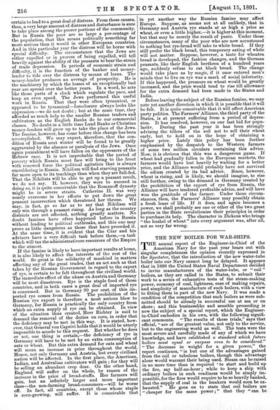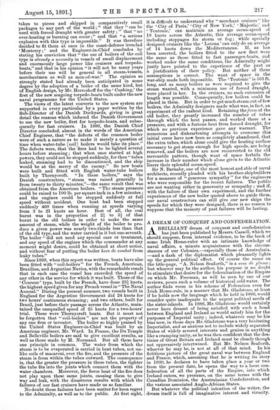THE NEW BOILER FOR WAR-SHIPS. T HE annual report of the
Engineer-in-Chief of the American Navy for the past year bears out with singular completeness the opinion recently expressed in the Spectator, that the introduction of the new water-tube boiler into our Navy cannot long be delayed. It appears that in 1888 the United States Naval Department decided to invite manufacturers of the water-tube, or " coil " boilers, as they are called in the States, to submit their work to a series of exhaustive tests of the steam-making power, economy of coal, lightness, ease of making repairs, and simplicity of manufacture of such boilers, with a view to fitting them in part of the new Navy. It was made a condition of the competition that such boilers as were sub- mitted should be already in successful use at sea or on shore ; and this businesslike and sensible proceeding is now the subject of a special report, which the Engineer- in-Chief embodies in his own, with the following signifi- cant comments. "The results of these trials," says that official, " are of the greatest value, not only to the service, but to the engineering world as well. The tests were the most severe and carefully made of any of which we have knowledge, and have establish,ed a standard which future boilers must equal or surpass even to be considered." "The decrease in weight for a given power," the report continues, "is but one of the advantages gained from the coil or tubulous boilers, though this advantage alone would warrant their being used. Steam can be raised in no more time than is required to start and build up the fire, say half-an-hour ; while to keep a ship with ordinary boilers in such readiness would be simply im- possible, for the fires would require to be so heavily banked, that the supply of coal in the bunkers would soon be ex- hausted." He goes on to state that coil boilers are "cheaper for the same power ; " that they "can be taken to pieces and shipped in comparatively small packsges to any part of the world ; " that they "can be used with forced draught with greater safety ; " that "no over-heating or burning can occur ;" and that "a serious explosion with this type is impossible." It was therefore decided to fit them at once in the coast-defence ironclad ' Monterey ; ' and the Engineer-in-Chief concludes by stating his conviction that "the use of boilers of the coil type is already a necessity in vessels of small displacement and enormously large power like cruisers and torpedo- boats," and that in his opinion "it will not be many years before their use will be general in all steam-vessels, merchantmen as well as men-of-war." The opinion so strongly stated had already been anticipated in some degree by the adoption of a boiler of the same kind, but of English design, by Mr. Herreshoff for the Cushing,' the first of the new seagoing torpedo-boats built under the new naval programme for the United States.
The views of the latest converts to the new system are supported in every particular by a paper written by the Sub-Director of the Danish Dockyards, giving in great detail the reasons which induced the Danish Government to use the new boiler, first for torpedo-boats, and subse- quently for fast cruisers. In 1886, the Danish Chief Director concluded, almost in the words of the American Chief Engineer, that "the defects of the common boiler were of such a nature as to make it merely a question of time when water-tube [coil] boilers would take its place." The defects were, that the fires had to be lighted several hours before steaming ; that when once started at high powers, they could not be stopped suddenly, for then" tubes leaked, steaming had to be discontinued, and the ship would be at the mercy of the enemy." So new boats were built and fitted with English water-tube boilers built by Thornycroft. "In these boilers," says the Danish constructors, "steam was raised generally in from twenty to thirty minutes,"—the same result that was obtained from the American boilers. "The steam pressure could be raised to 100 lb. per square inch in a few minutes ; and the engines could, be stopped suddenly at full speed without accident. One boat had been stopped suddenly 460 times when running at speeds varying from 3 to 21 knots an hour. Best of all, the coal burnt was in the proportion of 21 to 31 of that burnt in the old boilers in order to make the same amount of steam, while the weight of the boiler to pro- duce a given power was nearly two-thirds less than that of the old type, and the water carried in it but one-seventh.
The boiler "did not need any special care or treatment, and any speed of the engines which the commander at any moment might desire, could be obtained at short notice, and without fear of putting the boiler hors de combat from leaky tubes."
Since 1889, when this report was written, boats have also been fitted with "coil-boilers" for the French, American, Brazilian, and Argentine Navies, with the remarkable result that in each case the vessel has exceeded the speed of any other in the service for which it was built. Those of the Coureur ' type, built by the French, have done 231 knots, the highest speed given for any French vessel in" The Naval Annual." During the present summer, two vessels built in England for the Argentine Government did 24 knots for two hours' continuous steaming; and two others, built for Brazil, just before their passage across the Atlantic, main- tamed the unequalled speed of 25 knots for a two-hours' triaL These were Thornycroft boats. But it must not be forgotten that " coil-boilers " are not the property of any one firm or inventor. The boiler so highly praised by the "United States Engineer-in-Chief was built by an American engineer, Mr. Ward. In France, the Du Temple and Belleville boilers are said to give excellent results, as well as those made by M. Normand. But all these have one principle in common. The water from which the steam is to be evaporated is carried in bent tubes, not un- like coils of macaroni, over the fire, and the pressure of the steam is from within the tubes outward. The consequence is, that the greater the pressure in these tubes, the tighter the tube fits into the joints which connect them with the water chambers. Moreover, the fierce heat of the fire does not play upon these same joints, causing them to give way and leak, with the disastrous results with which the failures of our fast cruisers have made us so familiar.
No doubt these failures have been matter for keen regret to the Admiralty, as well as to the public. At first sight, it is difficult to understand why "merchant cruisers" like the City of Paris,' 'City of New York,' 'Majestic,' and Teutonic,' can maintain an average ocean-speed of 19 knots across the Atlantic, this average ocean-speed including stoppages for storm or fog ; while specially designed cruisers like the ' Latona ' can only do an average of 14 knots down the Mediterranean. If, as has been asserted, the boilers fitted to the new fleet were the same as those fitted to fast passenger-boats, and worked under the same conditions, the Admiralty might justly have pointed to the experience of the past as a justification of their policy. But neither of these assumptions is correct. The want of space in the war-ship made both impossible. The 'Teutonic' is 565 ft. long, and as many boilers as were required to give the steam wanted, with a minimum use of forced draught, were placed in her. In the cruisers, no such extension of length was possible. Consequently, few boilers could be placed in them. But in order to get much steam out of few boilers, the Admiralty designers made what was, in fact, an experiment of the rashest kind. Retaining the form of the old boiler, they greatly increased the number of tubes through which the heat passes, and worked these at a pressure, and with a furious heat from forced draught, for which no previous experience gave any warrant. The numerous and disheartening attempts to overcome this initial error have now been so completely abandoned, that the extra tubes, which alone could give the heating surface necessary to get steam enough for high speeds, are being removed, and the boilers are now reconverted to the old mercantile pattern, though want of space forbids the increase in their number which alone gives to the Atlantic liners their splendid ocean-speed. Sir N. Barnaby, one of the most honest and able of naval architects, recently pleaded with his brother-shipbuilders for a measure of "generous sympathy" for the engineers who were responsible for the recent failures. The public are not wanting either in generosity or sympathy ; and if, with the failure of their own experiment, and the further experiences of the new boiler quoted above to guide them, our naval constructors can still give our new ships the speeds for which they were designed, there is no reason to suppose that the memory of past failures will be lasting.



































 Previous page
Previous page